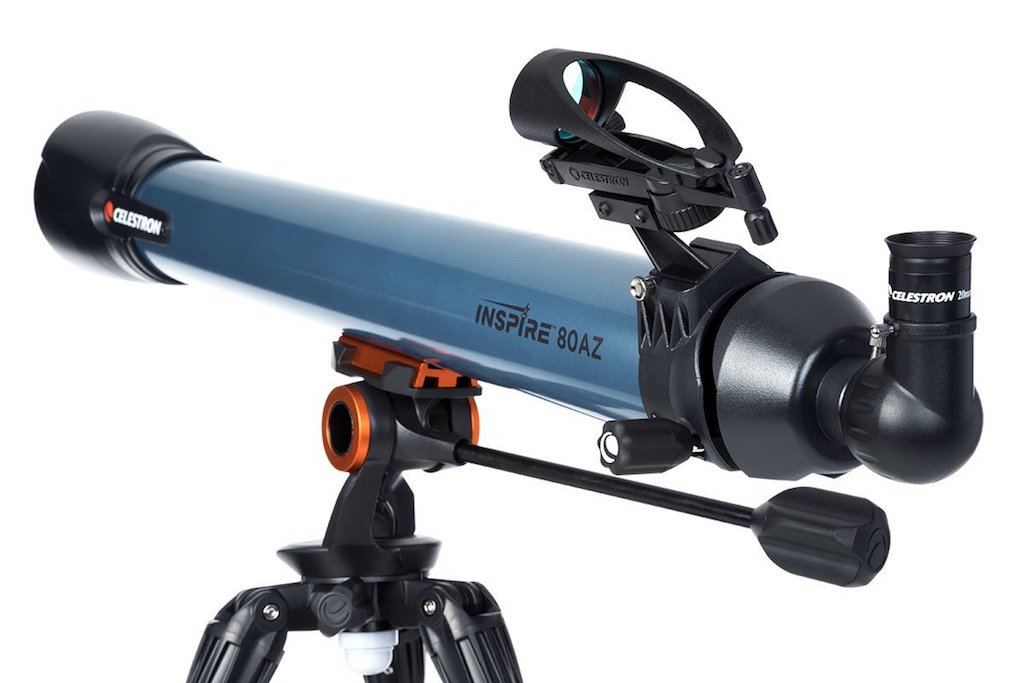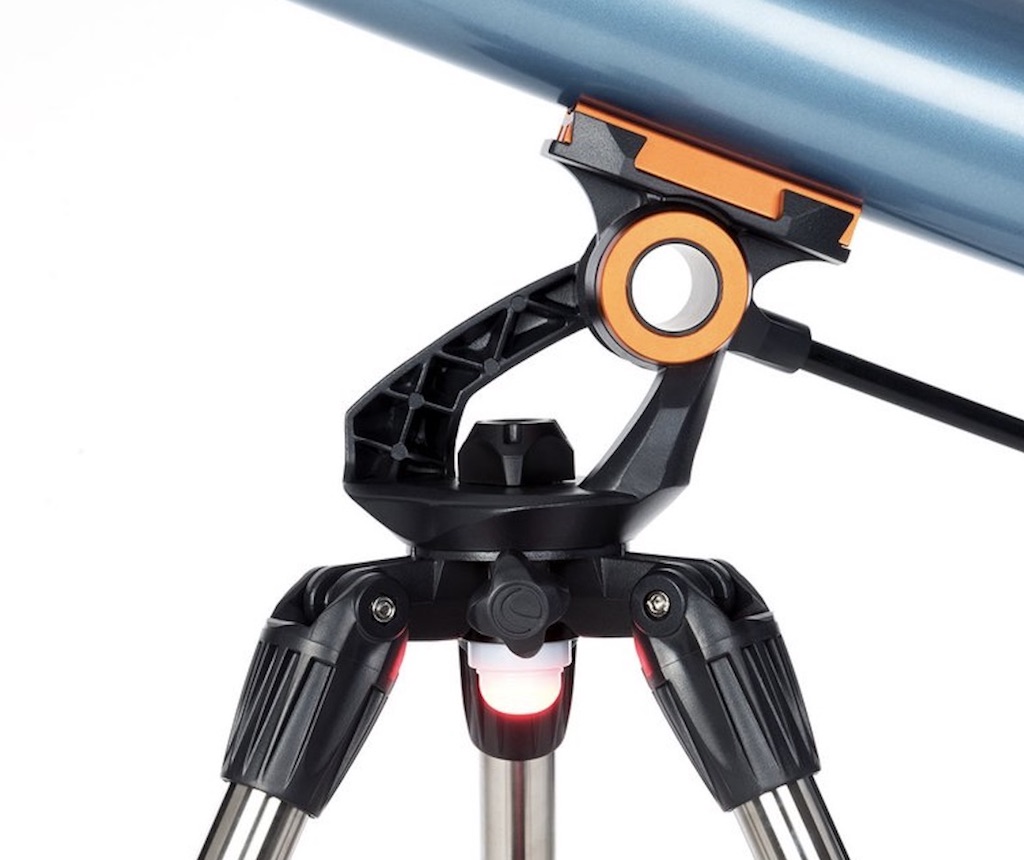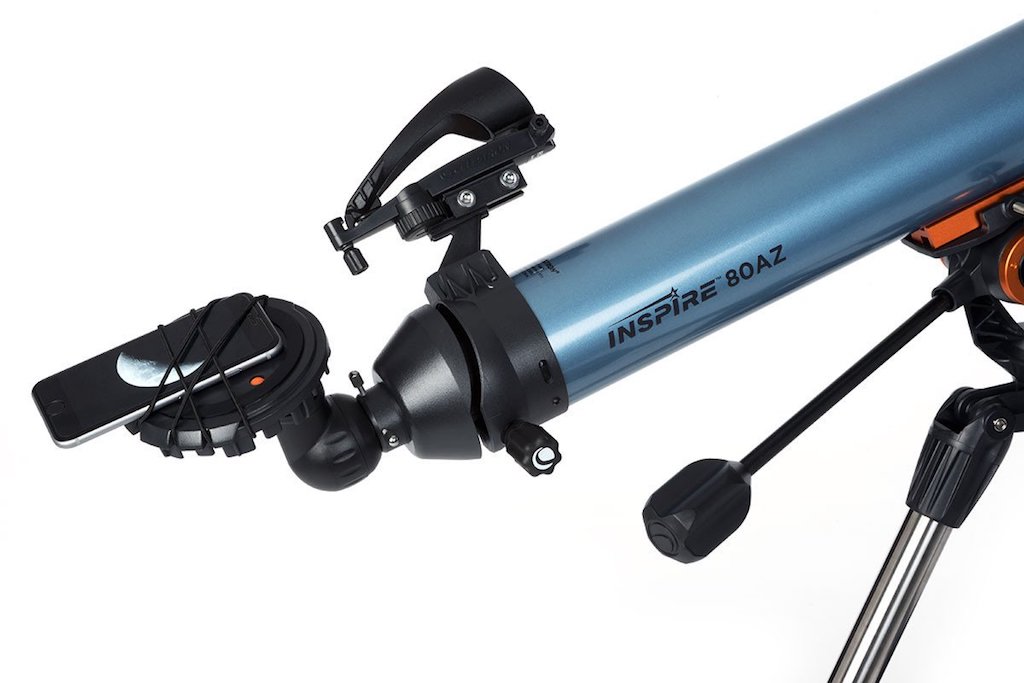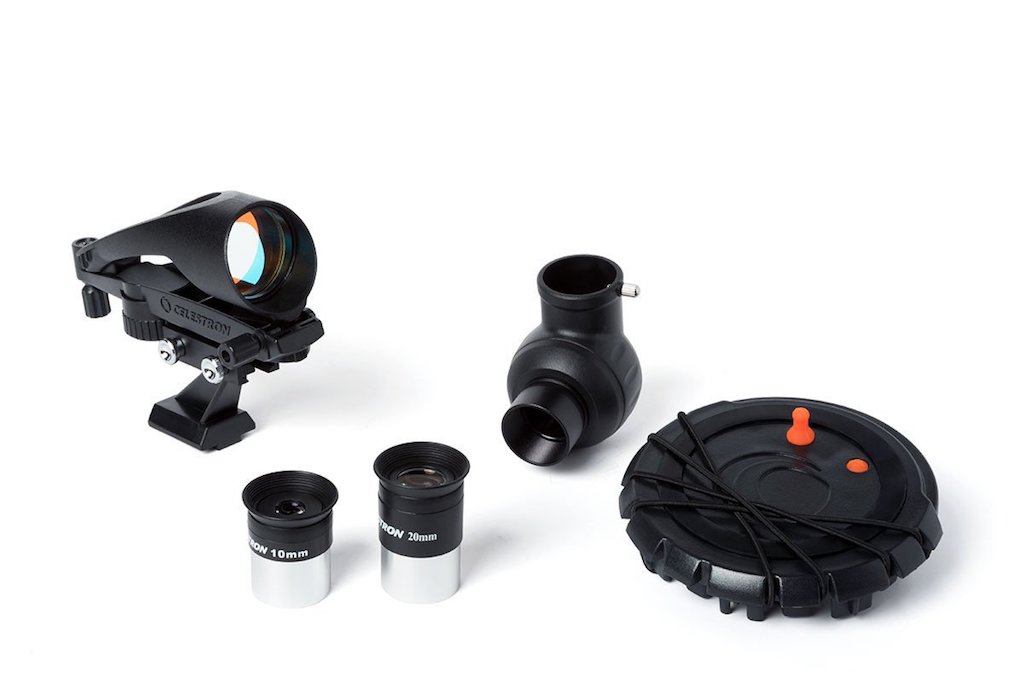Space Verdict
The Celestron Inspire 80AZ is an excellent telescope for a beginner — especially given that a complete package is offered, exudes portability and is easy to use and set up. The optics are of a good standard given the low investment but there is a degree of blurring in our field of view and an obvious amount of color fringing. The finish is of an excellent quality, with no obvious signs of poor workmanship and we appreciate the detachable LED red light and the smartphone holder as added bonuses to an already generous bundle.
Pros
- +
Offers more over most beginner packages
- +
Easy to build — no tools required
- +
Portable design
- +
High-quality finish
Cons
- -
Tracking targets is tricky
- -
Color fringing in optics
- -
Slight blurring in field of view — can be fixed with added eyepieces
Why you can trust Space.com
The Celestron Inspire 80AZ is the improved member of Celestron's original lineup of telescopes in the Inspire range. The manufacturer promises superior optics and developed accessories over its predecessor, assuring astronomers that terrestrial and celestial views are a simple set up away.
Optical design: Refractor
Aperture: 3.15" (80 mm)
Focal length: 35.43" (900 mm)
Focal ratio: f/11
Eyepiece 1 focal length: 20 mm (45x)
Eyepiece 2 focal length: 10 mm (90x)
Total kit weight: 16.98 lbs. (7.70 kg)
Mount type: Alt-azimuth
The assembly of this telescope is a fantastically straightforward aspect. You simply open up the tripod legs and secure the built-in accessory tray’s position, then fit the telescope tube into the dovetail lock on the alt-azimuth mount.
With an aperture of 3.51 inches (80 mm), this refractor is suitable for observations of the brighter members of the solar system, including the moon, Venus, Jupiter and Saturn. The optical system is also capable of providing closer views of brighter deep-sky targets such as the Andromeda Galaxy (Messier 31) and the Orion Nebula (Messier 42), which glow at magnitudes +3.44 and +4, respectively.
The Celestron Inspire 80AZ weighs in at 16.98 lbs. (7.70 kilograms), making it incredibly easy to transport beyond the backyard and to a dark-sky site without any trouble. Combine this with an easy setup, a simple-to-use alt-azimuth mount and everything you need for a good night of observing straight out of the box and you have an instrument geared towards beginners. What's more, the package costs below $300, so there's not much investment required to get started in skywatching.
Related: Best telescopes: Top picks for beginners, viewing planets, astrophotography and all-arounders
Celestron Inspire 80AZ: Design
- Complete observing package
- Tracking objects is a challenge
- High-quality finish to tube
On unboxing, the high-quality finish to the optical tube — painted a glossy light metallic blue — is immediately obvious, but it's great to see that Celestron hasn't strayed too far away from the orange that's been associated with the brand for many years. in particular, the Vixen-style dovetail bar has been fashioned in the iconic color, alongside orange embellishments on the mount. The Inspire 80AZ's dew shield and focuser are of good quality plastic that promises to last years of wear and tear. The achromatic doublet lens is fully coated for bright, clear views thanks to good light transmission.
The Inspire 80AZ comes with a 90-degree erect image diagonal with a 1.25-inch fitting that makes the telescope suitable for terrestrial and celestial views, a pair of Kellner eyepieces (20 mm and 10 mm), accessory tray and a StarPointer Pro finderscope. Many beginner telescopes are supplied with a flimsy optical finder that limits star-hopping or navigation to the brightest stars in the sky, but the Inspire 80AZ's StarPointer is a pleasant surprise — it's able to pick out faint stars under moderate light pollution for an accurate experience in finding our way around the night sky.
Breaking space news, the latest updates on rocket launches, skywatching events and more!
As an added bonus, there are other items that come with the Inspire 80AZ that are rarely included with a beginner’s telescope, including a dust cap that doubles as a smartphone holder and a detachable LED red flashlight. Red flashlights are important in preserving your night vision: your pupils — which take between 20 to 30 minutes to adjust to the dark — are unaffected by red light, leaving them dilated.
This red flashlight can either be attached to the mount to shine on the tripod tray, but can also be detached, making it a useful piece of kit to have in your observing arsenal, particularly if you lose an eyepiece in the grass or need to refer to a night sky guide.
The Inspire 80AZ is supplied with a code for a download of Celestron’s Starry Night astronomy software. This software will allow you to plan your observing sessions, but because this telescope doesn’t have a computerized mount, it's not possible to make the most of the software using the GoTo facility.
Without a computerized facility, you’ll have to manually slew the telescope to track a deep sky object, which requires the simultaneous movement along two axes: up and down as well as left to right. Tracking targets with this telescope can be a challenge since it requires a delicate, steady hand — something that can be a challenge to achieve for someone without any experience of using a telescope. However, practise does make perfect in mastering the controls for a satisfying observing experience.





Celestron Inspire 80AZ: First light and functionality
- Clear views, with false color observed
- Easy-to-use smartphone adapter
- Blurring improved with additions of eyepieces
One of our review sessions was focused on observations of the moon, which was almost full with a luminosity of roughly 90%. With the majority of the lunar surface available for us to see, we popped the 20 mm eyepiece into the fitting, fastening it into place with a single screw.
Related: Moon phases
At a magnification of 45x, the moon fits snuggly in the field of view but in order to gain close up views of craters, lunar mare and rilles, the 10 mm Kellner was our go-to eyepiece, bumping the magnification up to 90x.
Views are quite clear through this telescope as we slewed from the craters Tycho and Copernicus, but as expected and due to the Inspire 80AZ's reasonable price, there was a degree of false color along the lunar limb — we also recommend using a moon filter to improve the contrast, knocking back the brightness that often washes out the moon's stunning detail.
We discovered myriad photograph opportunities during our observations, affording us the opportunity to utilize the smartphone adapter that is supplied with the Inspire 80AZ package. Fortunately, our iPhone 11 was easy to attach thanks to a few elastic bands that held the smartphone in place — a simple, yet effective design, with no slippage.

If there is an option to switch your phone screen so that it emits red light to preserve your night vision, then this will greatly improve your observations, particularly of the fainter deep-sky targets.
Having just missed our opportunity to observe Jupiter, we turned our attention to the ringed gas giant Saturn, which at the time of our observations shone brightly at an impressive magnitude of +0.36.
Although the ringed giant's luminosity made the planet easy to navigate, the angular size of Saturn in the field of view was considered too small to fully appreciate the planet's beauty, even with the 10 mm eyepiece.
Refractor telescopes around the $300-mark commonly produce slightly blurry views, due to lens aberration, which created a challenge in resolving Saturn and its ring system. We recommend accessorizing the Inspire 80AZ with further eyepieces, being mindful of the telescope's useful magnifications of 11x and 189x to avoid blurring.
Of the two eyepieces, the 20 mm provides the much wider field of view, which means you are able to search a larger portion of the sky. This eyepiece is much more useful for more diffuse targets such as bright galaxies and nebulas, affording us the perfect opportunity to capture neighboring galaxy Andromeda.
The light-gathering capabilities of this telescope passed the test, as it revealed an oval patch of light with the large concentration luminance at the spiral galaxy's core. The 20 mm eyepiece displayed an adequate view with lower magnification.
Celestron Inspire 80AZ: Verdict
The Celestron Inspire 80AZ is an excellent telescope for a beginner — especially given the ease at which it can be set up, simplicity of use and the complete package that offers more in the way of accessories over most starter telescope bundles.
The optics are of a good enough standard to reveal some enjoyable targets in the night sky, providing fair views of the moon, planets and brighter deep-sky targets such as nebulas and galaxies. However, during observations, we did detect a degree of color fringing and blurring in the field of view. The latter is easily resolved with a careful selection of eyepieces, so we recommend investing in further eyepieces to make the most of the Inspire 80AZ's optical system.
The detachable LED red light and the smartphone adapter are features that are not usually supplied with many beginner telescopes but we certainly appreciate them. These extras are useful for preserving night vision and trying your hand at basic smartphone astrophotography and at no added cost to the astronomer.

Gemma currently works for the European Space Agency on content, communications and outreach, and was formerly the content director of Space.com, Live Science, science and space magazines How It Works and All About Space, history magazines All About History and History of War as well as Science, Technology, Engineering, Arts and Mathematics (STEAM) kids education brand Future Genius. She is the author of several books including "Quantum Physics in Minutes", "Haynes Owners’ Workshop Manual to the Large Hadron Collider" and "Haynes Owners’ Workshop Manual to the Milky Way". She holds a degree in physical sciences, a Master’s in astrophysics and a PhD in computational astrophysics. She was elected as a fellow of the Royal Astronomical Society in 2011. Previously, she worked for Nature's journal, Scientific Reports, and created scientific industry reports for the Institute of Physics and the British Antarctic Survey. She has covered stories and features for publications such as Physics World, Astronomy Now and Astrobiology Magazine.
